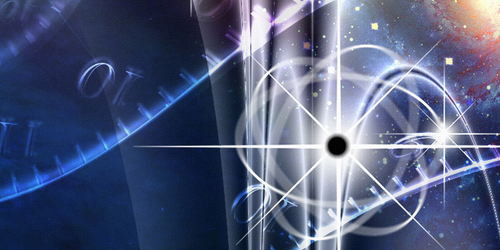Crystallizing the Path Toward a Nuclear Clock
From swinging pendulums to vibrating atoms, all clocks depend on reliable, periodic phenomena to keep time. An atomic clock’s ticks are defined by the frequency of the photon emitted by the excited-to-ground-state transition (deexcitation) of an electron in an atom. To go beyond the precision of the best clock of this type, researchers instead want to define ticks using the photon emitted by the deexcitation of an atom’s nucleus. Researchers recently demonstrated the use of ultraviolet light to induce such a transition in a promising candidate for a nuclear clock, thorium-229 (see Viewpoint: Shedding Light on the Thorium-299 Nuclear Clock Isomer). Now Ricky Elwell of the University of California, Los Angeles (UCLA) and his colleagues report the second demonstration of this feat [1]. As part of the demonstration, the researchers also determined the energy of the excited nuclear state more precisely than the previous team had done.
Thorium-229 holds a lofty position in metrology because one of its excited nuclear states has the lowest energy of all known excited nuclear states. The state also has a long enough lifetime that it might be accessed in a controlled way. Recently, researchers announced the first successful effort to manipulate this excited nuclear state of thorium-229 using light [2]. They also measured the excitation energy of this state, finding a value of 8.35574 eV.
That result and the new one were both achieved using devices that contained crystals doped with thorium-229, an idea proposed by some members of the UCLA team over a decade ago [3]. In their experiments, Elwell and his colleagues measured the excitation energy of thorium-229’s excited nuclear state to be 8.355733 eV, a more precise value than the earlier measurement, which used a different crystal. Their experiments also indicate that in some cases the host crystal can dampen the nuclear transition of thorium-229, an important consideration for future nuclear clocks.
–Rachel Berkowitz
Rachel Berkowitz is a Corresponding Editor for Physics Magazine based in Vancouver, Canada.
References
- R. Elwell et al., “Laser excitation of the 229Th nuclear isomeric transition in a solid-state host,” Phys. Rev. Lett. 133, 013201 (2024).
- J. Tiedau et al., “Laser excitation of the Th-229 nucleus,” Phys. Rev. Lett. 132 (2024).
- W. G. Rellergert et al., “Constraining the evolution of the fundamental constants with a solid-state optical frequency reference based on the 229Th nucleus,” Phys. Rev. Lett. 104 (2010).




